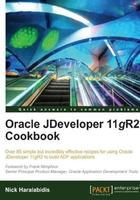
What this book covers
Chapter 1, Pre-requisites to Success: ADF Project Setup and Foundations, covers a number of recipes related to foundational concepts of Fusion web application development with ADF. By applying and expanding these recipes during the early architectural and design phases as needed, subsequent application development takes on a form, a structure, and the necessary uniformity. Many if not most of the recipes in the following chapters rely on these recipes.
Chapter 2, Dealing with Basics: Entity Objects, starts our journey into the world of ADF business components. First stop: entity objects. The recipes in this chapter deal with some of the most common framework functionality that is overridden in real world applications to provide customized business functionality.
Chapter 3, A Different Point of View: View Objects Techniques, covers a number of recipes related to view objects. This chapter explains how to control attribute updatability, how to set attribute default values, how to iterate view object row sets, and many more.
Chapter 4, Important Contributors: List of Values, Bind Variables, View Criteria, covers additional topics related to view objects. These topics include recipes related to list of values (LOVs), bind variables and view criteria. The reader will learn, among other things, how to setup multiple LOVs using a switcher attribute, cascading and static LOVs, and how to create view criteria programmatically.
Chapter 5, Putting them all together: Application Modules, includes a number of recipes related to application modules. You will learn, among others, how to create and use generic extension interfaces, expose a custom application module method as a web service and access a service interface from another application module. Additional recipes cover topics such as a passivation/activation framework, using shared application modules for static lookup data and custom database transactions.
Chapter 6, Go with the flow: Task Flows, delves into the world of ADF task flows. Among others, you will learn how to use an application module function as a method call to initialize a page, how to use a task flow initializer, how to retrieve the task flow definition programmatically and how to create a train.
Chapter 7, Face Value: ADF Faces, JSPX Pages and Components, includes recipes detailing the use of a variety of ADF Faces components, such as the query component, the popup window component, the tree component, the select many shuttle component, the carousel component, and others.
Chapter 8, Backing not Baking: Bean Recipes, introduces topics related to backing beans. A number of topics are covered including the use of custom table selection listeners, custom query and query operation listeners, session beans to preserve session-wide information, popup windows to handle long running tasks.
Chapter 9, Handling Security, Session Timeouts, Exceptions and Errors, covers topics related to handling security, session timeouts, exceptions and errors for an ADF Fusion web application. The recipes in this chapter will show the reader how to enable ADF security, how to use a custom login page, how to access the application's security information, how to detect and handle session timeouts, and how to use a custom error handler.
Chapter 10, Deploying ADF Applications, includes recipes related to the deployment of ADF Fusion web applications. These recipes include the configuration and use of the standalone WebLogic server, the deployment of applications on the standalone WebLogic server, the use of the ojdeploy tool and the use of Hudson as a continuous integration framework.
Chapter 11, Refactoring, Debugging, Profiling, Testing, deals with topics related to refactoring, debugging, profiling, and testing ADF Fusion web applications. The recipes in this chapter cover topics such as the synchronization of business components to changes in the database, refactoring of ADF components, configuring and using remote debugging, configuring logging in the WebLogic server, CPU profiling and the configuration, and usage of JUnit for unit testing.
Chapter 12, Optimizing, Fine-tuning and Monitoring, covers topics related to optimizing, fine-tuning, and monitoring ADF Fusion web applications. The recipes in this chapter demonstrate how to limit the rows fetched by view objects, how to limit large view object queries, how to use work managers for processing long-running tasks and how to monitor your application using the JRockit Mission Control.
Chapter 13, Miscellaneous Recipes, the additional content recipes cover topics related among others to using JasperReports, uploading images to the server, and handling and customizing database-related errors. This chapter is not present in the book but is available as a free download from the following link: http://www.packtpub.com/sites/default/files/downloads/4767EN_Chapter 13_Miscellaneous Recipes.pdf.